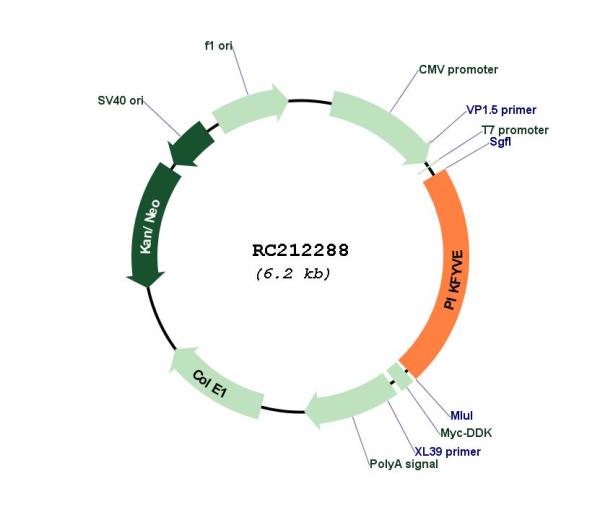PIP5K3 (PIKFYVE) (NM_152671) Human Tagged ORF Clone
CAT#: RC212288
PIKFYVE (Myc-DDK-tagged)-Human phosphoinositide kinase, FYVE finger containing (PIKFYVE), transcript variant 3
ORF Plasmid: tGFP
Lentiviral Particles: DDK w/ Puro mGFP w/ Puro
AAV Particle: DDK
"NM_152671" in other vectors (4)
USD 198.00
Specifications
| Product Data | |
| Type | Human Tagged ORF Clone |
| Tag | Myc-DDK |
| Symbol | PIP5K3 |
| Synonyms | CFD; FAB1; HEL37; PIP5K; PIP5K3; ZFYVE29 |
| Vector | pCMV6-Entry |
| E. coli Selection | Kanamycin (25 ug/mL) |
| Mammalian Cell Selection | Neomycin |
| Sequence Data |
>RC212288 representing NM_152671
Red=Cloning site Blue=ORF Green=Tags(s) TTTTGTAATACGACTCACTATAGGGCGGCCGGGAATTCGTCGACTGGATCCGGTACCGAGGAGATCTGCC GCCGCGATCGCC ATGGCCACAGATGATAAGACGTCCCCAACACTGGACTCTGCTAATGATTTGCCTCGATCTCCTACTAGTC CTTCTCATCTCACACACTTTAAACCTTTGACTCCTGATCAAGATGAGCCCCCTTTTAAATCAGCTTATAG TTCTTTTGTAAATCTCTTTCGTTTTAACAAAGAGAGAGCAGAAGGAGGCCAGGGAGAACAGCAGCCTTTG AGTGGAAGTTGGACCAGCCCTCAGCTCCCTTCGAGGACACAGTCTGTTAGGTCACCCACACCTTATAAAA AGCAGCTTAATGAGGAACTCCAGCGGCGCTCTTCAGCATTAGGAGACCTCCGAGCTTGCACATATTGTAG AAAAATAGCCTTAAGTTATGCTCATTCCACAGACAGTAATTCTATTGGGGAAGACTTGAATGCTCTTTCA GATTCTGCTTGCTCTGTGTCTGTGCTTGATCCAAGTGAACCCCGAACACCTGTTGGGAGTAGGAAAGCCA GCCGTAACATATTTTTAGAGGATGATTTGGCCTGGCAAAGTTTGATTCATCCAGATTCCTCAAATACTCC TCTTTCAACAAGACTTGTATCTGTGCAAGAGGATGCTGGGAAATCTCCTGCTCGAAATAGATCAGCCAGC ATTACTAACCTGTCACTGGATAGATCTGGTTCTCCTATGGTACCTTCATATGAGACATCTGTCAGTCCCC AGGCTAACCGAACATATGTTAGGACAGAGACCACTGAGGATGAACGCAAAATTCTTCTGGACAGTGTGCA GTTAAAAGACCTGTGGAAAAAAATCTGCCATCACAGCAGTGGAATGGAGTTTCAGGATCACCGCTACTGG TTGAGAACGCATCCCAACTGCATTGTAGGAAAGGAATTAGTCAACTGGCTAATCCGAAATGGGCATATTG CCACAAGGGCACAAGCTATAGCAATTGGACAAGCAATGGTTGATGGACGTTGGCTGGATTGTGTTAGTCA TCACGACCAGCTTTTCAGAGATGAGTATGCGCTGTATAGACCACTGCAGAGTACAGAATTTTCTGAGACG CCTTCTCCCGACAGTGACTCAGTGAACTCCGTGGAAGGACACTCTGAGCCATCCTGGTTTAAAGACATAA AGTTTGATGACAGTGACACAGAACAGATAGCTGAAGAAGGTGACGATAATTTGGCTAATTCTGCCAGTCC TAGCAAGCGCACATCAGTCAGCAGTTTCCAGTCCACAGTGGACAGTGACTCAGCCGCTTCTATCAGCCTG AACGTGGAGCTGGACAACGTGAACTTCCATATCAAGAAGCCCTCCAAGTACCCACATGTGCCCCCTCACC CTGCTGACCAAAAAGGTAGGAGG ACGCGTACGCGGCCGCTCGAGCAGAAACTCATCTCAGAAGAGGATCTGGCAGCAAATGATATCCTGGATT ACAAGGATGACGACGATAAGGTTTAA >RC212288 representing NM_152671
Red=Cloning site Green=Tags(s) MATDDKTSPTLDSANDLPRSPTSPSHLTHFKPLTPDQDEPPFKSAYSSFVNLFRFNKERAEGGQGEQQPL SGSWTSPQLPSRTQSVRSPTPYKKQLNEELQRRSSALGDLRACTYCRKIALSYAHSTDSNSIGEDLNALS DSACSVSVLDPSEPRTPVGSRKASRNIFLEDDLAWQSLIHPDSSNTPLSTRLVSVQEDAGKSPARNRSAS ITNLSLDRSGSPMVPSYETSVSPQANRTYVRTETTEDERKILLDSVQLKDLWKKICHHSSGMEFQDHRYW LRTHPNCIVGKELVNWLIRNGHIATRAQAIAIGQAMVDGRWLDCVSHHDQLFRDEYALYRPLQSTEFSET PSPDSDSVNSVEGHSEPSWFKDIKFDDSDTEQIAEEGDDNLANSASPSKRTSVSSFQSTVDSDSAASISL NVELDNVNFHIKKPSKYPHVPPHPADQKGRR TRTRPLEQKLISEEDLAANDILDYKDDDDKV |
| Chromatograms |
CHROMATOGRAMS
 Sequencher program is needed, download here. |
| Restriction Sites |
SgfI-MluI
Cloning Scheme for this gene
Plasmid Map

|
| ACCN | NM_152671 |
| ORF Size | 1353 bp |
| OTI Disclaimer | The molecular sequence of this clone aligns with the gene accession number as a point of reference only. However, individual transcript sequences of the same gene can differ through naturally occurring variations (e.g. polymorphisms), each with its own valid existence. This clone is substantially in agreement with the reference, but a complete review of all prevailing variants is recommended prior to use. More info |
| OTI Annotation | This clone was engineered to express the complete ORF with an expression tag. Expression varies depending on the nature of the gene. |
| Product Components | The ORF clone is ion-exchange column purified and shipped in a 2D barcoded Matrix tube containing 10ug of transfection-ready, dried plasmid DNA (reconstitute with 100 ul of water). |
| Reconstitution | 1. Centrifuge at 5,000xg for 5min. 2. Carefully open the tube and add 100ul of sterile water to dissolve the DNA. 3. Close the tube and incubate for 10 minutes at room temperature. 4. Briefly vortex the tube and then do a quick spin (less than 5000xg) to concentrate the liquid at the bottom. 5. Store the suspended plasmid at -20°C. The DNA is stable for at least one year from date of shipping when stored at -20°C. |
| Reference Data | |
| RefSeq | NM_152671.3, NP_689884.1 |
| RefSeq Size | 1661 bp |
| RefSeq ORF | 1356 bp |
| Locus ID | 200576 |
| UniProt ID | Q9Y2I7 |
| Cytogenetics | 2q34 |
| Domains | DEP |
| Protein Families | Druggable Genome |
| Protein Pathways | Endocytosis, Fc gamma R-mediated phagocytosis, Inositol phosphate metabolism, Metabolic pathways, Phosphatidylinositol signaling system, Regulation of actin cytoskeleton |
| MW | 50 kDa |
| Gene Summary | Phosphorylated derivatives of phosphatidylinositol (PtdIns) regulate cytoskeletal functions, membrane trafficking, and receptor signaling by recruiting protein complexes to cell- and endosomal-membranes. Humans have multiple PtdIns proteins that differ by the degree and position of phosphorylation of the inositol ring. This gene encodes an enzyme (PIKfyve; also known as phosphatidylinositol-3-phosphate 5-kinase type III or PIPKIII) that phosphorylates the D-5 position in PtdIns and phosphatidylinositol-3-phosphate (PtdIns3P) to make PtdIns5P and PtdIns(3,5)biphosphate. The D-5 position also can be phosphorylated by type I PtdIns4P-5-kinases (PIP5Ks) that are encoded by distinct genes and preferentially phosphorylate D-4 phosphorylated PtdIns. In contrast, PIKfyve preferentially phosphorylates D-3 phosphorylated PtdIns. In addition to being a lipid kinase, PIKfyve also has protein kinase activity. PIKfyve regulates endomembrane homeostasis and plays a role in the biogenesis of endosome carrier vesicles from early endosomes. Mutations in this gene cause corneal fleck dystrophy (CFD); an autosomal dominant disorder characterized by numerous small white flecks present in all layers of the corneal stroma. Histologically, these flecks appear to be keratocytes distended with lipid and mucopolysaccharide filled intracytoplasmic vacuoles. Alternative splicing results in multiple transcript variants encoding distinct isoforms.[provided by RefSeq, May 2010] |
Documents
| Product Manuals |
| FAQs |
| SDS |
Resources
Other Versions
| SKU | Description | Size | Price |
|---|---|---|---|
| RC212288L3 | Lenti ORF clone of Human phosphoinositide kinase, FYVE finger containing (PIKFYVE), transcript variant 3, Myc-DDK-tagged |
USD 757.00 |
|
| RC212288L4 | Lenti ORF clone of Human phosphoinositide kinase, FYVE finger containing (PIKFYVE), transcript variant 3, mGFP tagged |
USD 757.00 |
|
| RG212288 | PIKFYVE (tGFP-tagged) - Human phosphoinositide kinase, FYVE finger containing (PIKFYVE), transcript variant 3 |
USD 657.00 |
|
| SC313536 | PIKFYVE (untagged)-Human phosphoinositide kinase, FYVE finger containing (PIKFYVE), transcript variant 3 |
USD 503.00 |
{0} Product Review(s)
Be the first one to submit a review






























































































































































































































































 Germany
Germany
 Japan
Japan
 United Kingdom
United Kingdom
 China
China





